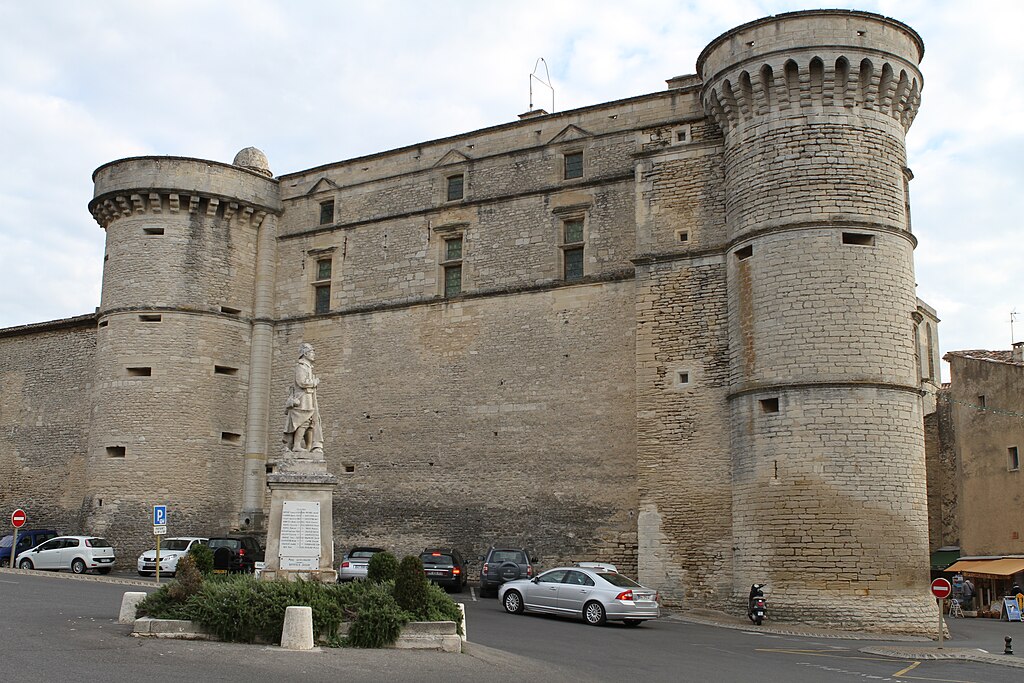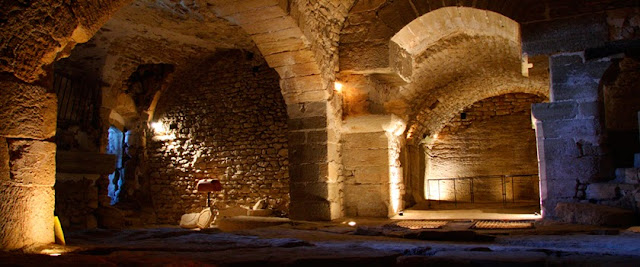Photo by Lviatour
Gordes is a village and a French commune, located in the department of Vaucluse, Provence-Alpes-Côte d'Azur. It's one of the most visited village of the regional park (massif) of Luberon. Perched on a rock, is recognized as one of the most beautiful villages in France, thanks to its rich and varied heritage: two abbeys, many ancient country houses, several water mills and windmills and hundreds of dry stone huts called "Borie" in French. Its inhabitants are called Gordian.
The origin of Gordes begins when the Celtic people of Vordenses erected a defensive Oppidum on the rock, where is now the village, to defend Cavaillon. Gordense comes from Vordense, called then Gordae and finally Gordes. Have a look to a stone engraved by Vordenses in a shot by Véronique Pagnier. There are still vestiges of Roman culture as the passage of Voie Romaine de Carpentras and the Bouisses neighborhood.
In the eighth century, the Benedictine abbey of Saint-Chaffret was founded by the monks of the abbey of Saint-Chaffre du Monastier-en-Velay on remnants of an ancient cella (inner chamber of a temple in classical architecture) destroyed during the arabs invasions.
It seems that back in the eleventh century, or perhaps earlier, the impressive castle that crowns the village of Gordes was built. Guillaume d'Agoult, a powerful warlord of that time, mentions it in a letter dated 30 November 1031. Their successors reinforce it and make it a nobile castrum (castle of the nobility). In the mid-fourteenth century the city is more than a city, a fortress. It seems that the fear generated by the 100 Years War between France and England taught his people to fortify their homes, all protected with high and strong stone walls. Gordes always distinguished by a strong opposition to the centralism of the French crown. In 1481 it was annexed to the kingdom of France and shortly exploded a strong uprising in which the city paid with blood its claims of independence.
In the mid-sixteenth century its castle was besieged without being taken during the Wars of Religions (a terrible civil war in France, 1562-1598, between Catholics and Calvinists, called Huguenots by the firsts) by the Baron des Adrets. The castle was later the home of the Marquis de Simiane, of the Duke of Soubise and the Princes of Condé.

Gordes is one of the first villages to accept the Protestant Reformation. In 1615 it became Marquis through the provision of King Louis XIII in favor of Guillaume de Simiane. The Marquis then goes to Rohan-Soubisse and finally to Condé. In the second half of the eighteenth century, the maintenance of the walls surrounding the village was gradually abandoned.
From the late eighteenth century to the second half of the nineteenth century, economic activity around Gordes is strong and the community is very well populated. In the early nineteenth century, the transformation of grain into flour is made in five water mills. The most important is the Moulin des Roberts, on Imergue River, in the town of Goult.
Moulin des Roberts by Map-France.com

With more business came prosperity. They produce olive, fig and almond. There is an increased production of silkworms. Exploits leather craft production with the manufacture of shoes. Wool and linen. And its famous raw material, the Gordes stones, which was used for construction, furnaces and fireplaces. The townspeople were always very entrepreneurial. They even had several iron mines, one of coal and one of sulfur. Peace and businesses. The best way to get people to live better.
Were equally strongly Republicans. They do not want the return of the monarchy and the privileges. Want privileges? Just work! They participated in an insurrection against the coup of December 2, 1851, by Louis Napoleon Bonaparte . At that time about 1600 Republicans lived in the village. By the late nineteenth and early twentieth century several earthquakes ravage the region. The steeple of the church, mills that produce electricity and several houses were affected. And a wave of intense cold profoundly affects agricultural production. By 1914, despite the vicissitudes, the village of Gordes had managed to replace their water mills with eighteen windmills. They are strong, these Gordian workers.
During the Second World War, Gordes is an important place for the Resistance. The town received the Croix de Guerre. On August 21, 1944, people are victim of violent reprisals by the Germans. They enter the houses of the few people who could not escape and murder them. The town was bombarded, dozens of homes and a total of twenty buildings were destroyed in retaliation or acts of war. After the war and the needed reconstruction, the village attracts more and more artists like Marc Chagall and Jean Deyrolle that discover the village in 1947 and make many friends (Serge Poliakoff, Vasarely, Dewasne, etc), come to live there. At present the main activities are related to tourism and real estate. Several exhibition rooms are also installed in the village.
Well, time to forget the war and go to have fun. Easy. Being in Paris take a train from Gare de Lyon (Place Louis Armand, Paris 12, Metro Lines 1 and 10) to Cavaillon. Here the timetable. Being in Cavaillon you have two options. By bus here the timetable for Ligne 15.3. Just 2 euros, cheap. Or book a taxi. Trip is 38 km, about 35-40 min. Fine, we are, at last, here in Gordes.
For a place to stay do not forget to book in advance. It's very important and never I will be tired to insist on this. Hotels and places to stay are very requested. Here at Hotels.com you will find many options in or close to Gordes. Select what you like and do not hesitate to book. If something goes wrong you will have plenty of time to cancel your reservation without paying a cent. You can also have a look to Trip Advisor that always has very good recommendations. It's a must to visit the Tourist Office. They always will have the most trusted and updated info about Gordes.
Let's have a communion with peace visiting the best places of the village. Time of tour, my friends. It's a must to visit the 16th century castle (originally built in 1031) and the mill. Photos above. Continuing with the town. Do you like paints? Visit the Galerie du Peintre Tapiézo, 7 Rue Richard Casteau, 84220, Roussillon, Gordes.
Do you like biking? Visit K-Lade and have a great time.

Le Sentier des Ocres is a landscape of ochre. Ochre is a natural pigment that is mixed in the sand cliffs. The iron oxide gives a color of yellow to purple. The scenery is breathtaking. Finally you will be taken to the Chaussée des Géants (Giant's Causeway) that will leave you speechless. You can book a visit here.
La Abbaye Notre-Dame de Sénanque is a Cistercian abbey founded in 1148 under the patronage of Alfant, bishop of Cavaillon, and Ramon Berenguer II, Count of Provence, by Cistercian monks of the Abbey of Mazan in the Ardèche.
Sénanque Abbey by EmDee.
Musée du Verre et du Vitrail is a museum exhibition of 600 m2 on a 3-hectare park that count 7000 years of history of glass and stained glass from the earliest times to the present. You can book for a guide visit in english here.
If you love wine, like me, is a must to visit the Bastide de Gordes Cave à Vins (The Wine Cellar). In the site you can book online.
Village des Bories: It is a unique and extraordinary place of its kind. It is a group of stone cottages, seven in total, each group having a specific function. Thus we have the rooms, stables, sheep pens, barns, breeding silkworms, fermenters, the press for wool, poultry houses, piggeries and goatherds. Have a look here for booking in advance.
Conservatoire des Ocres et de la Couleur (Ochre and Color Conservatory). If you enjoy painting this visit is mandatory. The Conservatory is within an area of five acres belonging to the ancient ocher factory led for more than three decades by Camille Mathieu, Mayor of Roussillon. The conservatory has recovered the ocher washing room and 2000 square meters where the ocher old mills of the village were located. To plan a visit have a look here.
Caves du Palais Saint Firmin (Wineries): The wineries are a set of troglodyte caves with underground stairs, tanks and an old manor oil mill. The cellars are maintained by a house called "Palai Saint Firmin". The place forms a network of caves scattered through seven levels with a gap between them of sixty feet. It is assumed that the caves are from the twelfth or thirteenth century. They were discovered by accident in 1961. It seems that the place was a mine used for extraction of the stone. Gordes had a golden age in the past where the economy was based mainly on the sale of stone for the construction of buildings, furnaces and fireplaces. You can book a visit here.

Moulin des Bouillons (Mill): It is a Gallo-Roman site inhabited since 2000 years. The olive oil mill was powered by blood, ie, driven by the strength of an animal, usually a donkey. It has been named historical monument and is the oldest mill which preserves all their work items. To visit have a look here.
Well my friends, that's all for today. But have before a complete list of the best restaurants in Gordes according to Trip Advisor. Enjoy your meal. Au revoir!
Gordes
Do not miss
- Best Towns in France
- Le Puy en Velay
- Baume les Messieurs
- Dinan
- Cassis
- Sainte Eulalie d'Olt
- La Roque Gageac
- Sainte-Agnès
- Lyons-la-Fôret
- La Bastide Clairence
- Yèvre-le-Châtel
- Locronan
- Preparing your trip to Paris
- Visiting Île de la Cité
- Visiting Le Grand Louvre
- Where to find the best France Tour
- Group Travel vs Single Travel
- How to be happy in Le Moulin Rouge
- A medieval day in Bruges
- Holiday Apartments in Europe
Ce blog est une fenêtre à travers laquelle le monde anglophone peut voir votre entreprise. Forfait à partir de 10 euros par mois, pas de clic ou impressions. Écrivez-moi si vous êtes intéressé. Ci-dessous, un formulaire de contact.